



Molot M-4 / Mya-4 / 3M
Myasishchev 'Bison'
The Molot (Hammer) was designed as a strategic bomber, but excessive fuel consumption of its engines and other design shortcomings limited its range to 8,000 km, which was insufficient for striking North American targets and returning to base. Consequently, along with the development of an improved version of the bomber with more fuel-efficient bypass engines and a new wing, a program was also initiated
to develop a specialized aircraft for aerial refueling. To facilitate operational support and formation
flight in the refueling process the bomber and the tanker aircraft were intended to have identical
design and performance characteristics.
Development of an intercontinental bomber with a strike capability at US-territory began in the early 1950s. The governmental order of 24 March 1951 provided for the establishment of a new design bureau headed by V.M. Myasishchev. The design bureau was in charge of organizing and manufacturing the development of the bomber which would have a range of 11000-12000 km, a maximum speed of 900km/h and could carry a payload of 5000 kg. The Bison was a Four-engined, swept-wing jet bomber with engines were buried in the wing roots. An unusual feature was the tandem landing gear, with small stabilising wheels at the tips of the drooping wings, and a nosewheel leg extended at take-off to achieve the correct angle of incidence.
Due to the fact that the high-power BD-5 engines for the aircraft were still in the development stage, the aircraft used four AM-3A turbojet engines developed by OKB A.A. Mikulina. The first prototype was finished in December 1952 and carried out its' first flight on 20 January 1953. It reached a speed of 947 km/h and a ceiling of 12500 m. Although the bomber had a range of only 8500 km, which did not allow strikes at US territory, series production of the M-4 bomber began in 1955 at the plant Nr. 23 in Moscow. In July 1955, deployment of the first ten bombers started.
- Bison A - M-4/2M -- The Bison A was the original version produced. It is characterized by a greenhouse nose and a nose refueling probe. It can be used in a free-fall strategic bombing role, but it is used primarily as a tanker for other Bison and Bear aircraft requiring in-flight refueling. Between 1956 and 1957, the M-4 was equipped with more powerful and low-consumption PD-3M and PD-3M-500A engines to increase range. And a prototype of the M-4, the M-4A, was equipped with an air refueling system and carried out its' first flight in 1956. Soon after series production started, studies were conducted on equipping the M-4 with the Kh-20 air-to-surface missile to strike at targets outside of the bomber's and to overcome air defenses. However, the landing gear did not allow placement of the missile under the fuselage and accommodation of the missile above the fuselage was rejected. In order to increase the range of the M-4 bomber, it was subsequently outfitted with new more powerful VD-7 engines. This new bomber had improved flight characteristics and a bigger propellant capacity relative to the M-4, with the maximum range increased up to 11850 km. An air refueling system increasing range up to 15400 km, which made these bombers the first strategic bomber capable of delivering its' payload into deep enemy territory and returning. The first flight of this bomber designated as 3M bomber took place in March 1956. At the end of 1956 series production of the 3M aircraft started at plant Nr.23, and deployment started in 1958.
- Bison B - 3M/M-6 -- The modified 3M (M-6) bomber was created in 1955. The Bison B has the same basic airframe configuration as Bison A, but it has a slightly larger wing, a longer nose, increased fuel load, higher thrust an improved bomb/nav system. Bison B is fitted with a nose refueling probe. Its primary mission is free-fall strategic bombing, but it can conduct alternate missions as a tanker when a removable bomb-bay refueling package is installed.
- Bison B - 3MS/M-6 -- The reliability of the VD-7 engines caused several problems and as a result, between 1958 and 1960 the bomber was outfitted with new RD-3M-500A engines. This bomber version is designated as 3MS. The range of the bombers without additional fuel tanks decreased to 9400 km.
- Bison B - 3MS/M-6 -- The associated 3MS2 tanker aircraft included refueling equipment in the bomb bay. The tanker variant used the "drogue and probe" aerial refueling technique in which the aircraft being refueled inserts a probe into a drogue at the end of a flexible hose extended from the tanker. This technique was also adopted by the U.S. Navy and the air forces of Great Britain, France, Italy, China and other countries. In unique contrast, the US Air Force adopted a refueling technique in which a telescoping boom is lowered from the tail portion of the tanker and enters a special socket on the aircraft being refueled).
- Bison C - 3MD/M-6 / 3MN -- In 1960 the 3MD bomber was developed, characterized by a slightly larger wing, a more pointed nose, a shorter and relocated nose refueling probe, and a larger tail radome. The Bison C has the same operational performance. Its primary mission is free-fall strategic bombing, but it can conduct alternate missions as a tanker when a removable bomb-bay refueling package is installed. The 1960 modification of the VD-7 engine - the VD-7B - provided better overall performance though smaller thrust was developed. The bombers outfitted with these engines received the designation 3MN. Their range was increased by 15 percent though they had a lower speed and a reduced ceiling.
- Bison C - 3MN-2 -- Several 3M bombers were converted into M-4-2 tanker aircraft, and during the development of the 3MS bomber the 3MS-2 tanker aircraft was developed in parallel. The tanker aircraft that was based on the 3MN received the designation 3MN-2. The 3MS-2 tanker aircraft air regiment was in operational service until 1994.
- Project 28 -- To overcome air defenses, a high-altitude version of the M-4 (project 28) was studied but not developed prior to the in 1960 to shut down the Myasishchev OKB.
- When OKB-23 was shut down in 1960, all activities to upgrade the Bison bombers ended. In the mid 1970s a Bison was experimentally equipped with two Kh-22 two air-to-surface missiles but this version was not deployed.
- 3M-T / BM-T "Atlant" -- In the late 1970s a single 3M bomber was converted to transport outsized components for the Energiya-Buran space launch system from the manufacturing facility to the Baikonur launch site. The cargo, including propellant tanks and the Buran orbiter itself, were placed on external mounting points located above the fuselage. This particular aircraft had a strengthened fuselage, a longer two-fin tail and a new flight control system. The original designation of the aircraft was 3M-T but was subsequently changed to BM-T "Atlant". The first flight took place on April 29, 1981 and the first flight with freight in January, 1982. The plane carried out a total of 150 flights.
In 1963, production of the Bison bombers stopped. A total of 93 aircraft, including ten M-4 and nine 3MD13 were built. The 3M bombers were in service with the Air Forces until the end of the 1980s, and were removed in accordance with the START-1 treaty on offensive strategic force reductions.
The 3MS2 tankers remained in service through 1994. The three airplanes that had been converted to transport oversized cargo are used for purposes unrelated to the START I Treaty; and are not reconnaissance airplanes, tanker airplanes, or jamming airplanes, and thus do not meet the definition of the term "former heavy bomber" provided for in the Definitions Annex to the Treaty. These airplanes are not included within the Treaty totals, though all other airplanes of the Bison type were considered to be former heavy bombers.
Specifications
|
| Soviet Designation | M-4/2M | 3M/M-6 | 3MS/M-6 | 3MD/M-6 |
| US-Designation | Bison A | Bison B | Bison B | Bison C |
| Remarks | Basic Aircraft | Slightly lager and improved | | Slightly changed nose and tail radome |
| Design Bureau | Myasishchev |
| Manufacturer | Plant Nr. 23 Moscow |
| Development began | 3/24/1951 |
| First Flight | 1/20/1953 | 3/27/1956 |
| Series production | 1954-1963 |
| Date deployed | 1956 | 1958 |
| Crew | 8 men | 7 men |
| Power Plant | Four AM-3, or
Four RD-3M-500, or
Four RD-3M-500A | Four VD-7 | Four RD-3M-500A | Four VD-7B |
| Thrust | 8,750kg
9,500kg
10,500kg each | 11,000kg each | 10,500kg each | 9,500 kg each |
| Length | 47.67m | 51.7m |
| Height | 11.5m |
| Wingspan | 50.53m | 53.14m |
| Wing surface | 326.35sqm | 351.7sqm |
| Speed Cruise [km/h] | 800 | 800 | 800 | 800 |
| Speed Maximum [km/h] | 930 | 940 | 925 | 925 |
| Ceiling | 12,500m |
| Altitude Over Target (m) | 12800 | 12725 | | 12725 |
| Weight (empty) [kg] | 79700 | 74430 |
| Operational Wt. Empty (kg) | 69500 | 71800 | | 71800 |
| Fuel Capacity (gal) | 29,500 | 34,000 | | 34,000 |
| Fuel weight |
| Maximum Takeoff Gross Weight [kg] | 165900 | 181800 | | 181800 |
| Normal load | 5,000kg | 5,000kg | 5,000kg | 5,000kg |
| Maximum load | 18,000kg | 24,000kg |
| Operational Range | 8,100km | 11,850km | 9,440km | 10,950km |
| Operational Range with refuelling | 8,100km | 15,400km | 12,400km | 13,600km |
| Unrefueled Combat Radius (kmi) | 4500 | 5000 | | 5000 |
| Maximum Range |
| Armament: | 18.000kg of free falling bombs | Free falling bombs with a caliber of up to 9.000kg when carrying a load of 24.000kg, two nuclear bombs with ha weight of 2.000kg or one 4.000kg bomb |
Historical Review - Western Estimates
|
| Bison A | Bison B | Bison C |
| Estimated start of flight testing | 1953 |
| First discovery | 30 July 1953 | 1956 | 1960 |
| Estimated start of series production | 1953 | 1956 | 1960 |
| Initial operational capability | 1955 | 1958 | 1960 |
| First public display (single aircraft} | 01 May 1954 |
| Public display of 13 aircraft | 01 May 1955 |
| End production | 1961 |
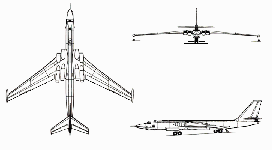
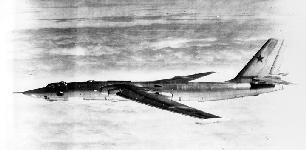
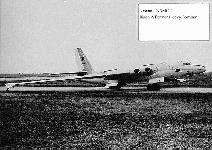
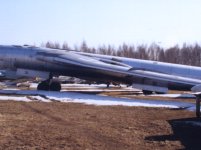
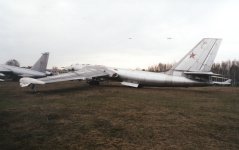
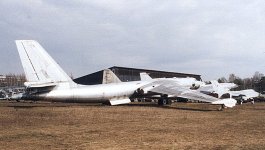
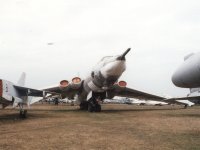

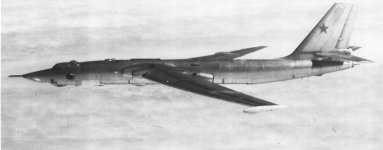
Sources and Resources
http://www.fas.org/nuke/guide/russia/bomber/m-4.htm
Implemented by John Pike,
Charles Vick,
Mirko Jacubowski,
and Patrick Garrett
Maintained by Webmaster
Updated Tuesday, August 08, 2000 5:40:16 PM














